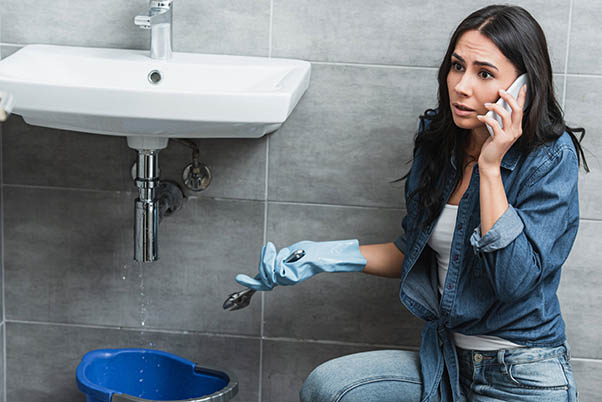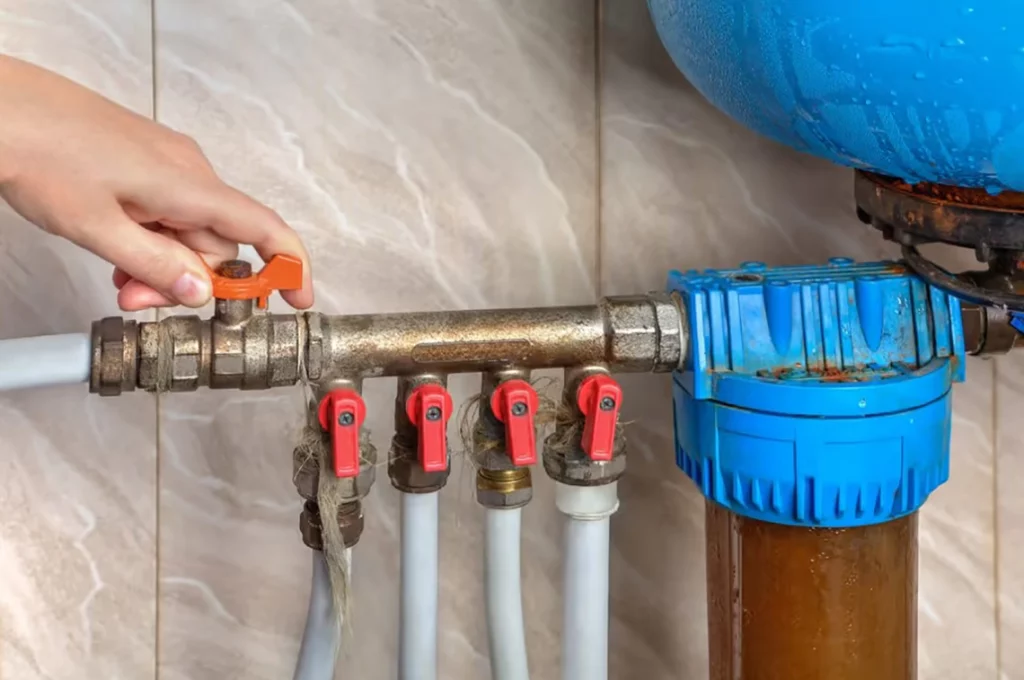We've encountered this article about Plumbing Emergencies: Tips on What To Do Before directly below on the net and decided it made sense to quickly share it with you on this page.

Pipes emergencies can strike at any time, triggering stress and anxiety and potential damage to your home. Whether it's a ruptured pipeline, a clogged drainpipe, or a leaky faucet, understanding just how to manage the situation up until an expert plumbing professional arrives can save you from additional issues. This post gives essential emergency plumbing suggestions to help you mitigate damages and reclaim control throughout a pipes dilemma.
Turn Off the Water Supply
The very first step in any kind of pipes emergency is to shut off the water supply. For local concerns, such as a dripping faucet or toilet, switch off the shutoff near the fixture. In the case of a significant leakage or burst pipe, situate your home's major water shut-off valve and turn it off immediately. Understanding the location of these shutoffs in advance can conserve important time during an emergency situation.
Shut down Your Water Heater
In certain emergencies, such as a burst pipeline, it's a good idea to shut down your hot water heater. This avoids getting too hot or damages to the system when water stops streaming. Turn off the power supply to the hot water heater (electric or gas) and allow it cool down to stay clear of potential hazards.
Briefly Stop a Ruptured Pipe
A ruptured pipe can bring about substantial water damage in minutes. To minimize the problem:
- Clamp or Wrap the Pipe: Make use of a pipe clamp, rubber, or duct tape as a short-lived seal.
- Draw Away Water Flow: If possible, draw away the water into a bucket or container to limit damage to bordering areas.
- Keep the Location Dry: Use towels or a wet/dry vacuum to get rid of standing water.
- Call an expert plumber quickly to attend to the problem completely.
Have an Emergency Situation Plumbing Set
Prepare a basic pipes emergency package to manage minor concerns efficiently. Your package ought to consist of: - Adjustable wrench
- Plumber's tape
- Pipeline secures
- Towels and cloths
- A bettor
- Epoxy putty
- Container.
- Having these devices available can make a substantial difference in your capacity to manage emergency situations.
Unclog Drains Safely.
A stopped up drain can be an irritating and messy problem. Here's exactly how to tackle it:. - Make use of a Plunger: For sinks or commodes, a plunger can typically displace minor obstructions. Guarantee you use the appropriate sort of plunger for the component.
- Warm Water and Dish Soap: For grease-related blockages, put a mixture of hot water and meal soap away to break up the grease.
- Avoid Chemical Drainpipe Cleaners: While appealing, chemical cleansers can create more damage than excellent, especially to older pipelines.
- If these approaches don't work, prevent making use of excessive force, as it might get worse the blockage.
Manage Overflowing Toilets.
An overflowing commode can create immediate mayhem. Right here's what you need to do:. - Quit the Water Flow: Remove the storage tank cover and weigh down on the flapper shutoff to quit water from entering the bowl. Turn off the water system to the bathroom if essential.
- Dive Delicately: Use a toilet plunger to clear the obstruction, however prevent hostile plunging, which can create spilling or more damages.
- Have the Spill: Usage towels or a wipe to tidy up water promptly to stop floor covering damages.
Address Little Leaks with Momentary Solutions.
Small leaks can rapidly become significant problems if left unchecked. Use these temporary solutions till specialist aid shows up:.
- Pipeline Tape or Epoxy Putty: Apply waterproof tape or epoxy putty to temporarily seal the leakage.
- Rubber and Clamp Approach: Cover an item of rubber or an old inner tube around the leak and secure it with a tube clamp or air duct tape.
- Pails or Towels: Location containers under the leak to contain water and prevent damages to floor covering or furniture.
- While these fixes aren't permanent, they can aid decrease water loss and damages.
Deal With Frozen Pipes Meticulously.
In cooler environments, frozen pipelines are an usual emergency. If you suspect an icy pipeline:. - Shut off the Water: Shut off the major water system to avoid a burst pipeline.
- Thaw Gradually: Utilize a hairdryer, heating pad, or cozy towels to thaw the pipeline gradually. Stay clear of open fires or extreme warmth, as these can damage the pipe.
- Check for Leaks: Once the pipeline is defrosted, check for splits or leaks prior to transforming the water back on.
Know When to Call a Professional.
While quick fixes can aid briefly, particular plumbing issues need immediate specialist attention. Call a plumbing professional if:.
- A burst pipeline triggers extensive flooding.
- Drains pipes or commodes stay clogged in spite of your efforts.
- You observe persistent leakages or water pressure problems.
- Your water heater is leaking or malfunctioning.
- Without delay speaking to an expert ensures the concern is fixed properly and protects against additional problems.
Stop Further Damages.
Taking quick activity to reduce damages can save you time and money over time. Here's just how:. - Move Valuables: Get rid of furniture, electronic devices, and other products from the afflicted location.
- Use Sandbags: For flooding situations, area sandbags around the area to redirect water.
- Turn off Power: If water has reached electric outlets or devices, turn off the electrical power to stop shocks or fires.
Verdict.
Plumbing emergencies can be overwhelming, however with the appropriate knowledge and tools, you can handle the circumstance properly until help arrives. By shutting off the water system, resolving tiny leakages, and making use of momentary repairs, you can reduce damage and keep your home safe. Remember, these pointers are short-lived remedies; constantly seek advice from an accredited plumbing to manage the source of the issue. Prep work and quick thinking are your finest allies in any type of plumbing emergency.
Emergency Plumbing: Quick Steps to Minimize Damage Before Help Arrives
Welcome to ?our? helpful guide,? “Emergency Plumbing: Quick Steps ?to ?Minimize Damage ?Before Help? Arrives”. Plumbing emergencies can lead to unanticipated ?stress and potential property damage if not addressed promptly and effectively. However, ?while professional help is definitely essential? in? such situations, there are things that you ?can ?do ?to minimize damage ?before a? plumber arrives. In this detailed, informative,? and easily? understood post, we provide you with practical,? expert advice on ?how to mitigate the? impact of common? plumbing ?emergencies. From identifying? the problem? to implementing temporary fixes,? this ?guide ?can equip you? with the? knowledge? you ?need to ?act swiftly and ?decisively,? potentially saving you? a lot ?of time, ?money and heartache. Imbibe these? critical insights and turn them into action, because when it comes? to plumbing emergencies, every minute? counts!
Understanding the ?Urgency of Plumbing Emergencies
Regardless ?of how well-maintained your? plumbing system ?may be, emergencies can happen when least expected. ?Burst pipes, ?leaks, blocked drains, gas ?leaks, and water heater issues are just samples of circumstances that call for immediate professional ?help. What? do you do when such emergencies occur? Most? importantly, how do? you minimize damage before help arrives?
First? and? foremost, stop the water flow, this ?is the? most immediate way to prevent extensive water damage. Locate your ?home’s main water valve and turn it off. If? the emergency is? a localized one,? like a? sink overflow, turning off the specific fixture’s valve under the sink will suffice. Secondly, ?switch off the electricity. ?This is ?crucial, especially ?when the? water ?leak is ?close to electrical? outlets or appliances. Lastly, clear the area; move furniture, rugs, ?and other valuables out of the ?way, especially if they are at risk? of water damage.
Recognizing Common? Signs ?of Plumbing Issues
Recognizing plumbing issues as soon as? they emerge can ?save you? from pricey repairs and potential ?water damage. For ?instance, slow drainage might suggest a blockage in? your pipes that,? if not dealt with, could result in ?a damaging overflow. Keep an eye out for? continuous dripping from your faucet even when? turned off ?- this is a clear ?sign of a faucet? issue that’s wasting water and increasing your? bill. A toilet that frequently runs? or takes a ?long time to ?refill could hint at an inner? part malfunction, while ?unusual? sounds ?- banging, whistling or gurgling – coming from your pipes signal abnormal flow or air in? the pipe.?
Increasing water bills without extra usage is also a sign of a possible leak in the system ?that causes water wastage.? Noticeable water stains or lush patches ?in? your? yard might indicate an outdoor leak. Lastly, low water ?pressure could imply a clog, a pipe problem, or even a city supply issue. Recognizing ?these signs early can provide you with ?a valuable? opportunity to address minor issues before ?they exacerbate ?into major plumbing emergencies. ?Signs? of? Common Plumbing Issues: Slow drainage Continuous dripping from? faucets High? water bills Unusual noises from ?pipes Lush patches in? yard Low water ?pressure
Preparing? an Emergency Plumbing Kit for Quick Action
A well-equipped? emergency? plumbing kit can mean the difference? between a minor ?inconvenience ?and? a? significant home ?disaster. To be? prepared for unexpected plumbing? emergencies, your ?kit should carry all the ?essentials that can help you limit ?the damage before professional help? arrives. The ?golden rule is start with? the basics? and then ?add tools as you navigate through different plumbing problems. Following are the core essentials you must? have? in ?your emergency ?plumbing kit:
- Plunger: ? This ?is a versatile tool? that can clear most minor clogs in ?sinks, toilets and? drains.
- Pipe Wrench: Essential ?for tightening and loosening? glazed? pipes.
- Pliers: Handy for gripping? small objects.
- Screwdriver ?Set: Used for ?removing ?or? tightening different fixtures.
- Teflon ?Tape: ? Can be wrapped around? fittings? and joints to ?prevent minor? leaks.
- Bucket: A simple bucket can be used for multiple purposes from catching leaks ?to carrying tools or storing? removed? parts.
Effective DIY Methods to Minimize Damage Before Help Arrives
When you promptly recognize a plumbing emergency, you can employ several DIY methods ?to mitigate potential harm while waiting for a professional plumber. ?Initially, it’s crucial? to ?turn? off the water supply ?to ?stop further flooding. If you’re encountering a local problem—like a? record-breaking overflow? from your toilet—its dedicated ?water valve? will usually be ?located ?behind the fixture. However,? if the? issue seems to be? more pervasive, you can cut your ?whole house’s water supply,? typically found near ?your water meter or at the? street.

Do you enjoy reading up on Expert Tips for Managing a Plumbing Emergency Until Help Arrives? Post a comment down the page. We will be glad to hear your responses about this content. We are looking forward that you visit us again in the future. Appreciated our posting? Please share it. Let others discover it. We appreciate your readership.
Details Here
Comments on “Critical Plumbing Tips: How to Manage Issues Until Assistance Arrives”